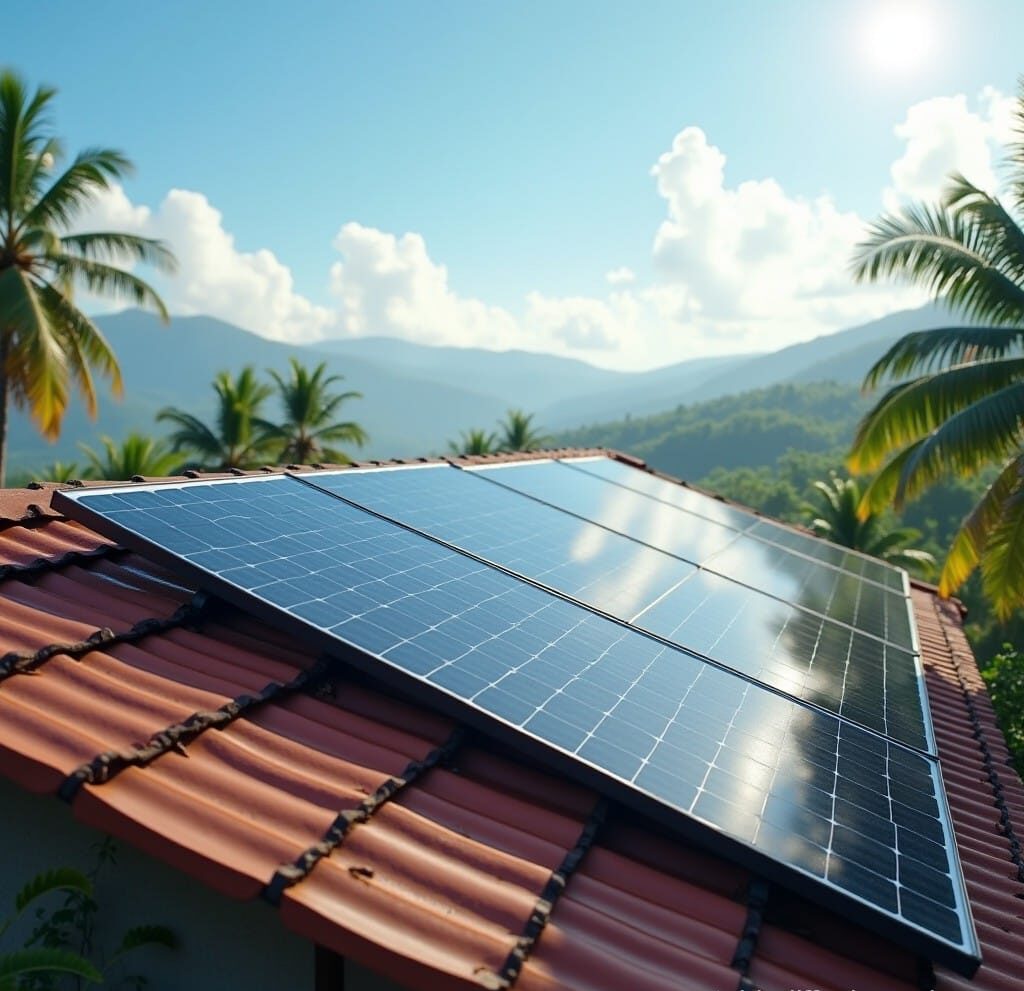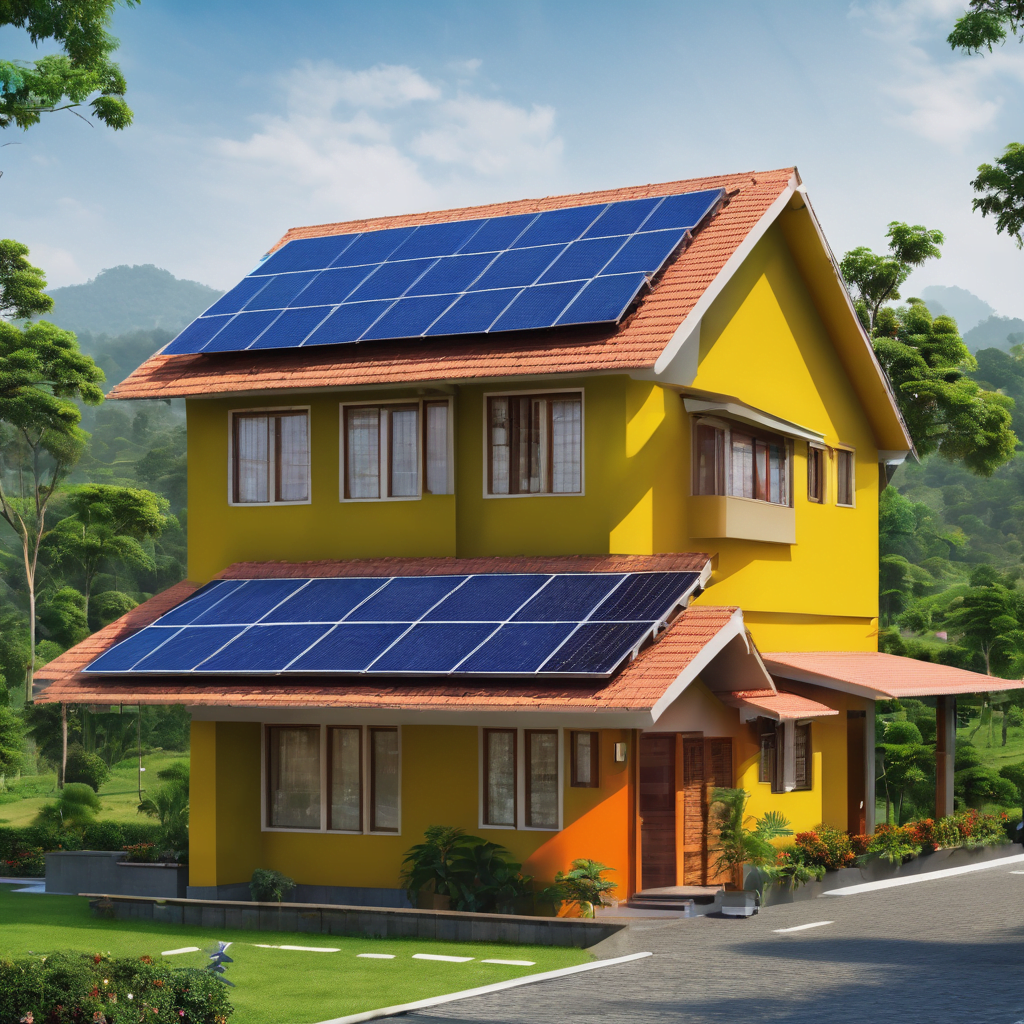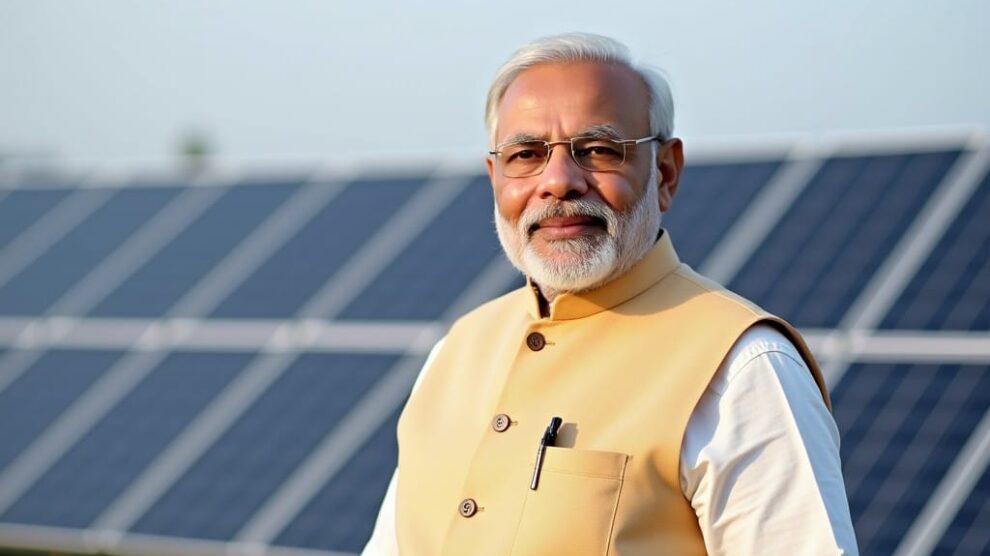Empowering Homes: Unveiling the MNRE Solar Rooftop Subsidy Scheme in Kerala 2025

In the radiant state of Kerala, where the sun’s embrace is abundant, the MNRE Solar Rooftop Subsidy Scheme for 2024 emerges as a beacon of opportunity for homeowners seeking to harness the power of solar energy. This comprehensive scheme, initiated by the Ministry of New and Renewable Energy (MNRE), aims to make solar energy more accessible and affordable. In this article, we delve into the benefits of the MNRE Solar Rooftop Subsidy Scheme in Kerala and how it can transform homes into eco-friendly power hubs.
Understanding the Scheme:
The MNRE Solar Rooftop Subsidy Scheme in Kerala 2025 is designed to encourage homeowners to adopt solar power by providing financial incentives and subsidies. The scheme is part of the government’s larger mission to promote clean and sustainable energy sources across the country.
Roles of Key Agencies in the Solar Subsidy Program
The successful rollout of the MNRE Solar Rooftop Subsidy Scheme in Kerala relies heavily on the coordinated efforts of government agencies. The Kerala State Electricity Board (KSEB) takes center stage, spearheading the on-ground implementation of the subsidy initiative. By organizing large-scale awareness and installation drives under national schemes like PM Surya Ghar, KSEB ensures smooth execution and participation throughout the state.
Meanwhile, the Agency for Non-conventional Energy and Rural Technology (ANERT) actively promotes solar adoption under programs like Surya Thejus. ANERT’s primary focus is to guide homeowners, streamline the application process, and connect residents with approved vendors—all while delivering equal access to the same financial incentives.
Backing these agencies, a network of approximately 35 certified installation companies works hand-in-hand with KSEB and ANERT to bring affordable solar rooftop solutions to households across Kerala. This collaborative ecosystem ensures that homeowners can confidently transition to solar power, with both administrative support and technical expertise at every step.
Key Benefits for Homeowners:
- Financial Incentives: Under the scheme, homeowners are eligible for a significant subsidy on the installation of solar rooftop systems. This financial incentive serves as a crucial motivator, making the transition to solar energy more financially viable for a broader range of homeowners.
- Reduced Energy Bills: By harnessing solar energy through rooftop installations, homeowners can significantly reduce their dependence on traditional grid power. This not only contributes to environmental sustainability but also leads to substantial savings on monthly energy bills.
- Low Maintenance Costs: Solar rooftop systems are known for their low maintenance requirements. Once installed, these systems generally incur minimal maintenance costs, providing homeowners with a reliable and cost-effective source of clean energy for years to come.
Payback Period: When Will Your Solar Investment Start Saving You Money?
One of the most common questions Kerala homeowners ask is, “How soon will my solar rooftop system pay for itself?” The answer is refreshingly bright. On average, residential solar systems in India reach their breakeven point within 6 to 8 years. This period can vary depending on several factors:
- Local Grid Electricity Costs: Higher utility rates accelerate your return, as every unit generated by your panels means more money saved.
- System Size and Cost: Larger systems require a higher upfront investment but can potentially result in faster savings if your household energy consumption matches the generation.
- Financing Options: Whether you pay outright, use a loan, or opt for another form of financing can affect your payback timeline.
- Household Energy Usage: The more solar energy you use on-site, the quicker you offset your initial investment.
The good news? Once your solar system has paid itself off—often well before its 25-year lifespan is up—all that clean, sun-powered energy goes straight into your pocket as savings. And with reliable brands like Tata Power Solar, Vikram Solar, and Waaree contributing to trusted installations across Kerala, you can enjoy decades of low-maintenance, cost-effective electricity.
Longevity of Solar Panels: How Many Years of Sunshine Can You Expect?
Homeowners often wonder about the lifespan of their solar panels, and rightly so—it’s an investment designed for the long haul. Most quality solar panels, such as those from reputable manufacturers like Tata Power Solar, Vikram Solar, and RenewSys, are built to last for decades. Typically, these panels come with a performance warranty of 25 years.
During this time, you can expect your panels to maintain the majority of their energy output—usually around 80-85% of their original capacity by the end of the warranty period. After 25 years, while their efficiency might slowly decline, your solar panels will continue to generate electricity, benefiting both your wallet and the environment for years beyond their official warranty.
With minimal maintenance, the robust design of modern solar panels ensures that your rooftop becomes a reliable source of clean energy well into the future.
Eligibility Criteria:
To avail the benefits of the MNRE Solar Rooftop Subsidy Scheme in Kerala 2025, homeowners must meet certain eligibility criteria:
- Residential Property Ownership: The scheme is applicable to homeowners who own residential properties in Kerala.
- Valid Rooftop Space: Eligible homes must have a suitable rooftop space for the installation of solar panels, ensuring optimal exposure to sunlight.
- Compliance with Technical Standards: Homes seeking to benefit from the scheme must adhere to the technical standards specified by MNRE for solar rooftop installations.
Quality and Certification of Solar Panels and Inverters
An essential aspect of the MNRE Solar Rooftop Subsidy Scheme is the emphasis on quality and reliability. The solar panels and inverters used in subsidized installations are required to meet stringent certification standards. Specifically, all components must be approved by the Bureau of Indian Standards (BIS) and comply with the Approved List of Models and Manufacturers (ALMM) as mandated by MNRE.
Before reaching your rooftop, each batch of solar panels undergoes rigorous testing directly at the manufacturer’s facility to ensure consistent performance and safety. In addition, MNRE periodically inspects both the equipment and the installed rooftop systems in the field, upholding continual quality assurance.
Rest assured, the inverters and solar panels selected under this scheme not only fulfill national standards, but also often hold relevant international certifications. This means your solar setup, whether sourced from leading brands like Tata Power Solar, Vikram Solar, or Waaree, is built to deliver dependable, long-term service—giving you peace of mind alongside sustainable energy savings.
Maximum Rooftop Area Needed per kWp Installation
When considering the installation of a solar rooftop system under the MNRE Subsidy Scheme, one of the most common questions is about space requirements. Typically, for every 1 kWp of solar panel capacity, homeowners should allocate up to 100 square feet of unobstructed rooftop area. This ensures the panels receive direct sunlight throughout the day.
Ideally, the selected portion of your rooftop should face south to capture maximum solar exposure, though east or west-facing orientations are also suitable if south-facing space is limited. Choosing a segment free from shade—whether from nearby buildings, trees, or water tanks—maximizes the efficiency and output of your system.
Careful evaluation of your roof’s suitability—factoring in orientation and shade—is recommended before moving ahead with your solar journey.
Apply for solar rooftop subsidy in Kerala:
The application process for the MNRE Solar Rooftop Subsidy Scheme in Kerala is streamlined to ensure ease of participation for homeowners:
- Online Registration: Homeowners can initiate the process by registering online through the designated portal. This typically involves providing essential details about the property, ownership, and the proposed solar installation.
- Document Verification: Upon registration, the authorities will verify the submitted documents and assess the property’s suitability for solar rooftop installations.
- Subsidy Disbursement: Once the application is approved, homeowners receive the specified subsidy amount, making it financially feasible to proceed with the solar installation.
How to Receive a Solar Subsidy Under the PM Surya Ghar (PM Muft Bijli Yojana) Scheme
Getting started with the PM Surya Ghar (PM Muft Bijli Yojana) scheme is straightforward if you follow these essential steps:
- Initiate Your Application: Visit the official MNRE portal or authorized website for the PM Surya Ghar scheme to begin your registration. Ensure you have all necessary details regarding your property, including proof of ownership, utility details, and the specifications of your proposed solar installation.
- Submit Required Documents: As part of the process, upload all relevant documents—such as property papers, proof of identity, and technical details—so that authorities can verify your eligibility and rooftop suitability.
- Await Inspection and Approval: Once your documents are submitted, your application will undergo a verification process. In some cases, an authorized team may visit your property to confirm the technical feasibility of installing solar panels.
- Receive Subsidy Approval and Disbursement: After successful verification, you’ll be notified of your eligibility and the subsidy amount sanctioned. The subsidy is typically credited directly to your bank account or adjusted against the installation cost.
By following these procedural steps, you can smoothly access the benefits of the PM Surya Ghar solar subsidy and move closer to sustainable, cost-effective energy for your home.
Understanding Net Metering for Home Solar Systems
Net metering is a vital feature for homeowners with grid-connected solar systems. It allows you to make the most of your solar power by balancing your energy production and consumption throughout the month.
Here’s how it works:
- Bidirectional Energy Flow: Your solar panels generate electricity during daylight hours—often producing more than your household actually uses at that moment.
- Grid as Your Backup: If you consume more power than your panels generate, you can seamlessly draw the extra electricity from the grid.
- Exporting Excess Power: When your system produces a surplus, the excess energy is automatically fed back into the local grid. For this contribution, you receive credits against your future electricity bills.
- Monthly Billing Made Simple: A special “net meter” tracks both the energy you draw from and supply to the grid. At the end of the month, your bill reflects the difference between what you’ve imported and what you’ve exported—ensuring you only pay for your net energy use.
In essence, net metering makes solar adoption both practical and economical, offering flexibility while maximizing your return on investment.
Installation Timeline for Residential Solar Systems
Curious about how soon you can start enjoying the benefits of your solar rooftop system after applying for the subsidy? The delivery and installation process is designed to be efficient, allowing most homeowners to get up and running without lengthy delays.
Here’s what you can expect:
- Materials Delivery: After your payment is received and all documentation is in order, the materials for your solar system are typically delivered within 15 days.
- System Installation: Once the materials arrive, the actual installation on your rooftop generally takes another 10–15 days, depending on factors like weather, structural requirements, and ease of access.
- Net Meter Connection: Finally, the net meter—enabling you to export surplus solar energy back to the grid—is usually connected by the relevant electricity board within about 15 days after installation completion.
In total, most residential solar systems are fully installed and commissioned within approximately 30–45 days from payment and approval, under normal conditions. This allows you to start harnessing solar power with minimal wait and begin reaping the financial and environmental benefits sooner.
Amount of Subsidy Available:
The subsidy amount provided under the MNRE Solar Rooftop Subsidy Scheme varies based on factors such as the capacity of the solar system and the location of the property. Typically, homeowners can receive a substantial percentage of the total installation cost as a subsidy.
| Rooftop Solar System Capacity | Applicable Subsidy (₹) |
| Up to 2 kW | ₹30,000/kW |
| Above 2 kW and up to 3 kW | ₹18,000/kW* |
| Above 3kW up to 20kW | ₹78,000** |
| Resident Welfare Associations (RWA) / Group Housing Societies (GHS) | Rs. 18,000/- per kWFor common facilities up to 500 kWp @ 10 kWp per house, with the upper limit being inclusive of individual rooftop plants already installed by individual residents in that GHS/RWA at the time of installation of RTS for common activity. |
| Note: *₹30,000/kW for the first 2 kW and ₹18,000/kW for the rest of the capacity up to 3 kW.**The subsidy amount is fixed for rooftop solar systems above 3 kW capacity. | |
| Solar System Size | Estimated Price Range | Subsidy Applicable | Prices After Subsidy |
| 3kW Solar System | Rs. 1,89,000 – Rs. 2,15,000 | Rs. 78000/- | Rs. 1,11,236 – Rs. 1,37,236 |
| 4kW Solar System | Rs. 2,52,000 – Rs. 2,85,600 | Rs. 78000/- | Rs. 2,00,942 – Rs. 2,34,542 |
| 5kW Solar System | Rs. 3,15,000 – Rs. 3,57,000 | Rs. 78000/- | Rs. 2,37,648 – Rs. 2,79,648 |
| 10kW Solar System | Rs. 5,31,000 – Rs. 6,07,000 | Rs. 78000/- | Rs. 4,36,178 – Rs. 5,12,178 |
Expected Monthly Generation from a 1 kWp Solar System
When considering a rooftop solar installation, it’s essential to understand how much electricity a 1 kWp (kilowatt-peak) solar system typically produces each month. On average, you can expect a 1 kWp system to generate between 90 and 120 units (kWh) of electricity per month, depending on local sunlight availability and installation conditions.
This means, for example, that a 3 kW solar system could generate approximately 270 to 360 units monthly, significantly offsetting your electricity bills and contributing to cleaner energy consumption at home. Keep in mind that actual generation can vary based on factors such as panel orientation, shading, and seasonal weather patterns.
Estimating the Solar Capacity You Need
Wondering how much solar capacity you’ll need to cover your household’s power needs? Here’s a simple way to work it out using your electricity bills and a bit of math—no engineering degree required.
Start by gathering your power bills for the past year (or at least a few months), and add up the total number of units (kWh) you’ve consumed. Solar systems in India typically generate around 90–120 units per month for every 1 kW of capacity, depending on sunlight, roof orientation, and local weather.
To find your ideal solar system size:
- Calculate Your Monthly Usage: Total your last year’s electricity units and divide by 12 for a monthly average.
- Divide by Expected Output: Take your average monthly usage and divide it by 100 (as a midpoint between 90–120 units/kW).
- Result: This gives you an estimate, in kilowatts, of the solar plant size that will meet your needs.
For example:
- If your monthly average consumption is 600 units,
- Divide 600 by 100;
- You’d need about a 6 kW solar system.
Of course, for a more tailored estimate, professional solar consultants can assess your site and suggest the perfect system based on panel brand (like Adani or Axitec), inverter options, and specific installation factors. This ensures you’ll soak up every ray of Kerala sunshine, maximize savings, and make the most of government subsidies.
Regional Differences in Benchmark Prices and Subsidy Rates
While the central MNRE subsidy framework offers a consistent baseline for support, the actual benchmark prices and subsidy rates can differ significantly from state to state in India. This variation is shaped by each state’s individual solar policies, local installation costs, and incentives offered by their respective energy authorities.
For example, states like Gujarat or Rajasthan—where solar adoption has been particularly robust—may have their own additional incentives or specific benchmarks that can influence your total savings. Some states periodically revise their benchmark rates based on factors like prevailing market prices for solar panels, local labor costs, and grid infrastructure improvements.
It’s wise to check the latest circulars from your state’s renewable energy development agency (such as GEDA in Gujarat or ANERT in Kerala) to see how benchmark prices and eligibility thresholds are set locally. Working with an experienced solar installer—one familiar with policies across multiple states—ensures you don’t miss out on favorable rates or updated subsidies that may apply right where you live.
The MNRE Solar Rooftop Subsidy Scheme in Kerala 2023 opens new doors for homeowners to embrace clean and sustainable energy. By providing financial incentives and reducing the barriers to entry, the scheme empowers households to contribute to a greener and more eco-friendly future. As Kerala basks in the abundant sunlight, the MNRE Solar Rooftop Subsidy Scheme invites homeowners to join the solar revolution, transforming their homes into energy-efficient havens and contributing to the collective effort towards a sustainable tomorrow

Comparing Monocrystalline and Polycrystalline Panels: Efficiency and Cost
When choosing between monocrystalline and polycrystalline solar panels, two key factors usually top the list: efficiency and price. Let’s break down how these two popular solar technologies stack up for homeowners in Kerala.
Efficiency at a Glance
- Monocrystalline panels—crafted from a single crystal structure—are known for their higher efficiency. That means they can convert more sunlight into electricity using less space, which is handy if your rooftop area is limited.
- Polycrystalline panels, on the other hand, use multiple silicon crystals. Their efficiency tends to be a bit lower, so they’ll require a bit more surface area to generate the same amount of electricity as their monocrystalline counterparts.
But here’s the key: No matter which you choose, a properly sized 3 kW solar system—whether mono or poly—will deliver the promised output under standard conditions. The real variance lies in how much roof space you’ll need.
Cost Considerations
- Monocrystalline panels generally come at a premium due to their higher efficiency and more complex manufacturing process.
- Polycrystalline panels offer a more budget-friendly price point, making them an attractive choice if roof space isn’t a constraint.
So, if space on your roof is limited and you want to maximize power in a compact area, paying extra for monocrystalline panels might make sense. However, if you have ample rooftop real estate, polycrystalline panels can deliver the same energy output at a lower overall system cost—often making them the more cost-effective solution for many Kerala homes.
Quick Recap:
- Monocrystalline: Higher efficiency, smaller footprint, higher price.
- Polycrystalline: Slightly lower efficiency, larger footprint, lower cost.
Deciding between the two usually comes down to balancing your available space with your budget and long-term energy needs. And with the MNRE subsidy, either choice becomes even more accessible for Kerala homeowners.
Choosing Between Polycrystalline and Monocrystalline Panels: Which Is More Cost-Effective?
When deciding between polycrystalline and monocrystalline solar panels, the most important factor often comes down to your available roof space and budget. Both types are engineered to deliver the rated output—so a 3 kW system will produce roughly the same amount of power, regardless of which technology you select, as long as conditions and specifications remain the same.
However, monocrystalline panels pack more power into a smaller area thanks to their higher efficiency. This means they’re an excellent fit for homes or buildings where roof space is limited but you want to maximize your solar capacity. The trade-off? They usually come at a premium price compared to their polycrystalline counterparts.
For homeowners with generous roof space, polycrystalline panels present a strong value proposition:
- Lower upfront costs: Polycrystalline modules are generally more affordable, helping you save on your initial investment.
- Proven durability: These panels have a track record spanning decades, offering reliable performance.
- Ample space, easy expansion: If space isn’t an issue, you can install additional polycrystalline panels to achieve your desired power output while keeping costs in check.
In summary, polycrystalline panels are the most cost-effective choice when you have plenty of roof area or land to work with and are seeking to keep your project’s budget lean. For homes where every square meter counts, investing in monocrystalline panels may be worth the higher upfront cost. Both technologies continue to improve, but matching your selection to your site and financial goals is the best way to maximize your solar investment.
Polycrystalline vs. Monocrystalline Solar Panels: What’s the Real Difference?
When considering a rooftop solar installation, one of the questions that often comes up is whether to choose polycrystalline or monocrystalline solar panels. The distinction mainly lies in efficiency, space usage, and cost.
Polycrystalline Panels:
Polycrystalline panels have been in the market for decades, earning a reputation for reliability and affordability. They are crafted from multiple silicon crystals and generally require a bit more roof space to achieve the same output as their monocrystalline counterparts. For most homes, however, polycrystalline panels offer excellent value—especially if you aren’t squeezed for roof space. Their lower price point can make it easier to achieve your desired energy output without stretching your budget.
Monocrystalline Panels:
Monocrystalline panels, like those from Adani or Axitec, are made from a single piece of silicon, allowing them to deliver higher efficiency in converting sunlight to electricity. The main advantage is the ability to generate the same amount of power as polycrystalline panels while using less area—ideal if your usable roof space is limited. However, this increased efficiency comes at a slightly higher cost.
Key Takeaways:
- Efficiency: Monocrystalline panels tend to be a bit more efficient, meaning you get more power per square meter.
- Cost: Polycrystalline panels are typically more budget-friendly.
- Space: If space is limited, monocrystalline panels make sense. But if you have ample roof space, polycrystalline can be more cost-effective.
- Performance: Regardless of the type, a panel rated at 3 kW will generate the same power under standardized testing, whether it’s mono or poly.
In short, the decision often comes down to your roof size, aesthetic preferences, and budget. Both options are proven technologies that can power your home efficiently for years to come.
Accepted Payment Methods for Your Solar Purchase
When it comes to paying for your new home solar system, you have plenty of hassle-free options. For your convenience, we accept multiple widely-used payment methods, including:
- Direct bank transfers (RTGS/NEFT/IMPS)
- UPI platforms such as Google Pay, PayTM, and PhonePe
- Cheques and demand drafts
- Major credit and debit cards
- Cash payments (for amounts less than ₹2 lakhs, as per regulatory guidelines)
Rest assured, every payment is fully accounted for and accompanied by an official receipt as soon as your payment reflects in the bank. This ensures you can move forward with confidence as you take your next step toward sustainable energy for your home.
Illuminating Homes: Unlocking the MNRE Subsidy for Solar Rooftops in Kerala

In the sun-kissed state of Kerala, the transition to cleaner and more sustainable energy solutions has never been more promising. One avenue gaining traction is the adoption of solar rooftops—a transformative way for homeowners to harness the abundant solar energy. Amidst this solar revolution, the Ministry of New and Renewable Energy (MNRE) presents a game-changing opportunity through its subsidy program for solar rooftops in Kerala.
Harnessing the Sun: The Benefits of Solar Rooftops
Solar rooftops stand as silent powerhouses, converting sunlight into electricity and reducing dependence on conventional grid power. Beyond the environmental impact, homeowners benefit from reduced energy bills, low maintenance costs, and the satisfaction of contributing to a greener future.
MNRE Subsidy: Empowering Homes with Clean Energy
The MNRE subsidy for solar rooftops in Kerala is a beacon of support for homeowners eager to embrace solar power. This financial incentive aims to make solar installations more accessible and affordable, catalyzing the shift towards sustainable energy sources.
Eligibility Criteria: Opening Doors to Solar Dreams
To qualify for the MNRE subsidy, homeowners must own residential properties in Kerala, possess a suitable rooftop space for solar installations, and comply with technical standards set by MNRE. This inclusive approach ensures that a wide range of households can benefit from the subsidy.
Application Process: A Seamless Transition to Solar
The application process is designed for simplicity and accessibility. Homeowners can register online, providing essential property details. Post-registration, a thorough document verification ensures compliance, leading to the disbursement of the subsidy amount. The subsidy varies based on factors such as system capacity and location, offering a significant financial boost to eligible homeowners.
Empirical Evidence: MNRE’s Impact in Numbers
The impact of MNRE subsidies is evident in the rising number of solar installations across Kerala. With a surge in solar-powered homes, the state is witnessing a tangible reduction in carbon footprint and energy bills, contributing to a more sustainable and economically viable future.
Shining Examples: Large-Scale Solar Projects in Kerala
Kerala’s solar journey is dotted with impressive success stories from across the state, demonstrating how major organizations have powered their facilities with clean, renewable energy. Leading hospitals, educational centers, and corporate offices have made the switch, exemplifying the broader movement toward sustainability.
Consider these real-world highlights:
- Prominent multi-specialty hospitals in Kochi, Calicut, and Thrissur are operating with solar plants in the 1000 kWp (1 MW) range, primarily utilizing high-efficiency panels from international leaders like SolarWorld (Germany), Longi Solar, and Jinko Solar, paired with robust inverters from respected brands such as SMA (Germany) and Goodwe.
- Media organizations, engineering colleges, shopping malls, amusement parks, and government departments have also adopted rooftop solar, with capacities spanning from 600 kWp down to smaller yet impactful installations of 15–100 kWp.
- Across these diverse sites, the emphasis remains on reliable components, optimizing both output and long-term savings.
This wave of large-scale projects is helping to set the standard—not just for Kerala, but for India’s entire solar transformation—by reducing operational costs and championing the use of renewable resources at scale.
Seize the Solar Opportunity: Key Takeaways
In conclusion, the MNRE subsidy for solar rooftops in Kerala is a golden opportunity for homeowners to embrace clean energy and make a positive impact on both the environment and their wallets. As the sun continues to shine on Kerala, now is the time to take advantage of this subsidy, ushering in a new era of sustainable living. Illuminate your home and contribute to a brighter, greener future by harnessing the power of the sun with the MNRE subsidy for solar rooftops.
Empowering Kerala: Unlocking the Benefits of MNRE Solar Rooftop Subsidy
In the sun-drenched state of Kerala, the Ministry of New and Renewable Energy (MNRE) Solar Rooftop Subsidy emerges as a game-changer, bringing a ray of financial sunshine to homeowners and businesses alike. This subsidy program is not just about harnessing solar power; it’s about transforming the energy landscape and reaping tangible benefits.

1. Financial Boost for Homeowners: One of the primary advantages of the MNRE Solar Rooftop Subsidy in Kerala is the significant financial support it offers to homeowners. By providing a subsidy on the installation cost of solar rooftops, the MNRE empowers households to make the transition to clean energy without breaking the bank.
2. Reduced Energy Bills: The subsidy not only makes the initial investment more affordable but also translates into long-term savings on energy bills. Solar rooftops generate electricity from the abundant sunlight, allowing homeowners to offset or even eliminate their dependence on traditional grid power, leading to substantial cost reductions over time.
3. Environmental Sustainability: Beyond financial gains, the MNRE subsidy promotes environmental sustainability. Solar power is a clean and renewable energy source that reduces reliance on fossil fuels, curbing carbon emissions and contributing to Kerala’s efforts towards a greener and more eco-friendly future.
4. Business Advantages: For businesses in Kerala, the MNRE Solar Rooftop Subsidy is a strategic investment. It not only lowers operational costs by cutting down on electricity expenses but also enhances the brand image by showcasing a commitment to sustainability. This resonates well with environmentally conscious consumers, creating a competitive edge in the market.
5. Long-Term Returns on Investment: The MNRE subsidy transforms solar rooftop installations into a smart investment. While the initial costs are reduced through the subsidy, the long-term returns on investment are substantial. Solar rooftops typically have low maintenance costs and come with warranties, ensuring a reliable and cost-effective energy solution for years to come.
In conclusion, the MNRE Solar Rooftop Subsidy in Kerala is a catalyst for positive change. It empowers homeowners and businesses to embrace clean energy, reduce costs, and contribute to the sustainable development of the state. As the sun continues to shine on Kerala, the MNRE subsidy stands as a beacon, inviting individuals and businesses to seize the opportunity and illuminate a brighter, greener future.
Brighten Your Home: A Guide on How to Apply for Solar Rooftop Subsidy in Kerala

As Kerala embraces the solar revolution, the Ministry of New and Renewable Energy (MNRE) offers a golden opportunity for homeowners and businesses to transition to clean energy through the Solar Rooftop Subsidy. Here’s a comprehensive guide on how to apply for this subsidy, unlocking a world of benefits for those eager to harness the power of the sun.
1. Eligibility Criteria: Before diving into the application process, it’s crucial to ensure eligibility. Homeowners and businesses owning properties in Kerala with suitable rooftop space for solar installations are eligible. Compliance with MNRE’s technical standards is also essential.
2. Online Registration: The application process kicks off with online registration. Visit the MNRE’s designated portal, providing necessary details about your property, ownership, and proposed solar installation. The user-friendly interface ensures a smooth registration process.
3. Document Verification: Once registered, the authorities will conduct a thorough verification of the submitted documents. This step ensures that the property aligns with the technical specifications required for solar rooftop installations. Accuracy and completeness in document submission are crucial for a seamless verification process.
4. Subsidy Disbursement: Upon successful verification, the MNRE disburses the specified subsidy amount. The subsidy varies based on factors such as the capacity of the solar system and the location of the property. This financial incentive significantly reduces the upfront costs, making the switch to solar energy more affordable.
Advantages for Homeowners:
- Financial Incentive: The subsidy makes solar installations more accessible and affordable, offering a significant financial boost to homeowners.
- Reduced Energy Bills: Solar rooftops lead to substantial savings on monthly energy bills, providing a cost-effective and sustainable energy solution.
Applying for the Solar Rooftop Subsidy in Kerala is a transformative step towards a brighter, greener future. By following these steps, homeowners and businesses can not only contribute to environmental sustainability but also enjoy financial benefits and long-term savings. Seize the opportunity, apply for the subsidy, and illuminate your home or business with the power of solar energy
